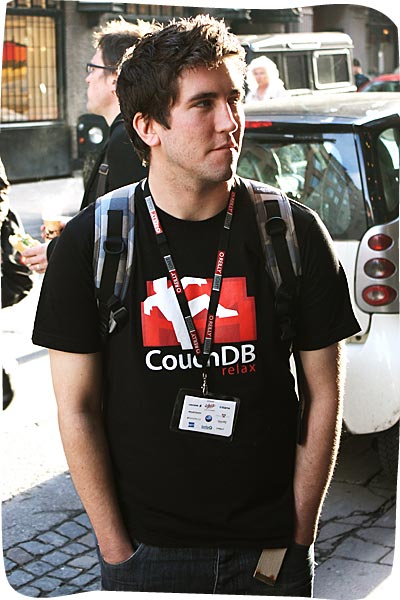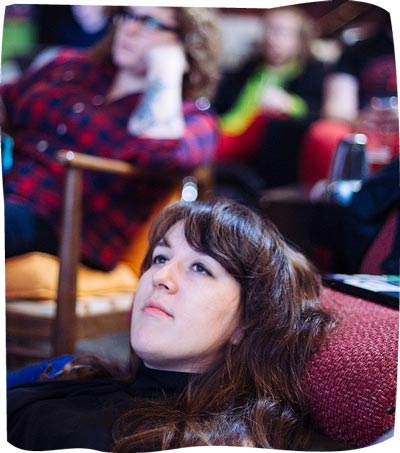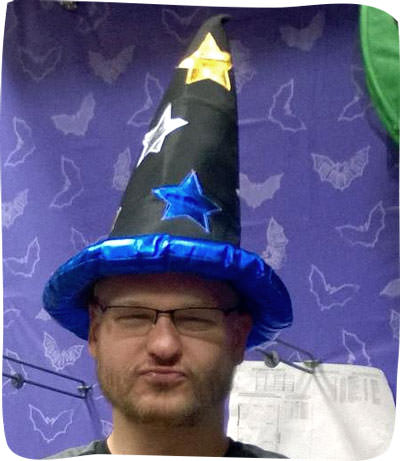Two days, one track, 16 speakers with 16 talks!

Barbara oversees the development of OANDA’s next-generation APIs. She acts as the internal and external evangelist for the API product suite as well as OANDA’s developer community. Prior to joining OANDA, Barbara worked as senior architect and performance advocate at the Canadian Broadcasting Corporation (CBC) where she focused on mobile web development and performance optimization. She holds an honours BSc from the Bonn-Rhein-Sieg University of Applied Sciences, Germany.
Barbara is an international speaker, a book author, a contributor to jsmanners and the organizer of the Toronto Web Performance Meetup Group.
Copy, paste, but don’t block the rendering! It’s almost impossible to find a website that doesn’t utilize any kind of embedded widgets such as ads, social plugins, or analytics: All of these add-ons are considered 3rd party scripts and promise to increase and benefit publisher’s revenue. Publishers don’t have much control over the provider’s code and inevitably just have to trust their integrity, content security policy, code quality, and performance.
Imagine a high-traffic website hosting a twitter widget: Are publishers aware that a sudden twitter server outage could potentially bring down their site if the widget is not properly included?
The performance and availability of 3rd party scripts don’t have to become a threat or a nightmare for publishers. Barbara’s talk will not only outline best practices, tools, and tricks on how to sandbox 3rd party scripts, but also help the audience understand bottlenecks, determine potential risks, and elaborate on how to measure their performance.
Following this session, managers and developers will be equipped to ask the right questions when choosing 3rd party providers, while developers will be armed with guidelines on how to integrate 3rd party snippets efficiently into their deployment process without slowing down or even bringing down their site. Go watch the video of Barbara’s talk ➡

First and foremost an amateur cat photographer, Brian’s second passion is music. After a short stint as a college radio DJ, Brian taught himself to play bass and in the last 10 years has played for a handful of bands of varying notoriety. His most recent project, a shoegaze band out of Brooklyn called Eastern Hollows, is planning to release their second full length in the summer of 2015.
When not playing music Brian tries his best to make a positive contribution the New York developer community as a co-founder and organizer of BrooklynJS, a monthly user group featuring talks, musical performance and terrible jokes.
Learning to be a better developer through the teachings of Black Flag, My Bloody Valentine, and John Cage. Go watch the video of Brian’s talk ➡

Brittany is a Senior Engineer at Mozilla, working to ease developer struggles with modern app development. She believes in life, liberty and the pursuit of happiness, and has been known to pick up pencils with her toes. She also writes a lot of JavaScript.
Over time, we've developed solid conventions and best practices for building our applications with a sustainable architecture. We've explained them in writing and highlighted them in demonstrative apps, but the most exemplary instance of application architecture will not be found in the pages of a book or code in a text editor.
Rather, it's found in the modularity of our organs. It's found in the speed of complex communication between our brains and our bodies. It's found in the processes like breathing and blinking that run seamlessly in our backgrounds.
Our bodies consistently demonstrate the best practices and patterns we aim for in our software every day. Let's investigate how our biology makes the most irrefutable case for the designs we've come to value in application development. Go watch the video of Brittany’s talk ➡

C J Silverio has worked for many Silicon Valley startups, writing everything from smart cellphone apps to web servers to user interface design to in browser web apps, with a recent focus on node.js services. She currently leads dev/ops for npm Inc.
Or, how we split a monolith and lived to tell the tale.
This is the story of how npm replaced its monolithic registry service with
microservices. We rolled out the registry without any users noticing
this huge change behind the scenes. How did we manage this? What did we
mess up? What can you learn from our experience?
Go watch the video of CJ’s talk ➡

Christian is a passionate programmer working with Oslo-based consultancy Kodemaker. He's a man of eclectic background, having worked with everything from Unix systems tuning and ops to various server-side applications and JavaScript heavy frontend development.
Christian is the author of "Test-Driven JavaScript Development", and he maintains several open source projects, including the popular mocking framework Sinon.JS. Emacs and Lisp turned him onto functional programming many years ago, and Clojure/ClojureScript has deepened his fascination with the subject.
When it comes to functional programming techniques seeing widespread adoption in the JavaScript community, immutability is a strong contender for "next in line". In this talk I'll show you what immutability is all about, why it's useful, and how to work with it. We'll even put immutability to work in a React app and observe how we can reduce complexity while increasing performance. Go watch the video of Christian’s talk ➡

Dale is a senior developer on the Firefox OS project for Mozilla, a long time CouchDB contributor, PouchDB maintainer and is generally interested in working on Open Source and the Open Web.
The web is slowly becoming more capable however the experiences it provides still generally fall far behind what native applications are already doing. I want to take a look at how offline architectures can help bring the best experiences to your users and discuss the technologies, from appcache and service workers to PouchDB that will help you build the native web. Go watch the video of Dale’s talk ➡

David is a Senior Program Manager working for Microsoft Corp, in charge of driving adoption of HTML5 standards. He’s speaking in several famous web conferences such as Paris Web, CodeMotion, ReasonsTo or jQuery UK. He’s the co-author of the WebGL Babylon.js open-source engine. Read his blog on MSDN or follow him on Twitter.
During this session, we will see thanks to babylon.js, a free & open source engine written in TypeScript, how we can easily create and use 3D content with associated sounds directly with JavaScript. We will also see how to interact with DCC tools like Unity or Blender to work with 3D designer. Spatial sounds, gamepad, physics effects: all those goodies are available for you in a few lines of code! Demos will be done in our latest browser engine. Go watch the video of David’s talk ➡

Fergus is a senior consultant at Comperio who likes to make stuff in JavaScript. He is the author of Norch, Search-Index, and many other songs of code. A co-founder of The Oslo Bike Kitchen, he can often be found taking things apart and putting them back together again.
Search-index is a module for doing free-text search in Javascript. In this talk we will explore various approaches to indexing data on the server and in the browser. We will show how search-index integrates with other technologies presented at WebRebels such as Browserify, the Level family, PouchDB and NPM, together with code examples. The talk should serve as a jumping off point for engineers looking to use search-index, and creative types who want to create new concepts around "Small Data". Go watch the video of Fergus’ talk ➡

Jenn Schiffer is an open web engineer at Bocoup who creates art, and tools facilitating the creation and learning of art, using code and other aspects of technology.
Imagine a world where dolphins could walk. Now forget that and then imagine a world where you had the power to create musical and art experiences in the browser for free, without expensive software or hired contractors. I'm going to talk about creating web-based audio-powered visualizations using weird "technologies" like "C.S.S." and "JavaScript" and "code." Go watch the video of Jenn’s talk ➡

Lars has worked on Javascript engines for many years — at Opera, at Adobe, and now at Mozilla, where he works on shared-memory and multicore technologies for JS and asm.js.
My phone has four cores, my laptop has eight, and my workstation has sixteen, but my scripts can only easily use one core at a time. We need to give JavaScript access to the full power of the machine, if web apps are to remain as capable as native apps. Workers communicating with events and marshaled data are safe, but slow and awkward; Parallel JS is also safe, but again slow and awkward. The power remains locked away. So what are we to do?
Suppose we sacrifice a little safety for a lot of performance: We give JavaScript workers access to shared memory, and let them truly share data and communicate through the shared memory. A low-level framework is all we need initially; libraries can provide data-parallel abstractions, task queues, synchronization, and similar. Such a framework is available in Firefox Nightly now, and I will present it and demo some things we can do with it. Go watch the video of Lars’ talk ➡

Linda Sandvik is a Knight-Mozilla OpenNews fellow at the Guardian, a creative technologist and proto-MacGyver who likes to make things that inform, educate, and empower people and communities. She previously worked in local government and at Last.fm, and co-founded Code Club. Her particular interests lie in using play and technology to help people discover their natural affinity for teaching themselves new things. She has a passion for open data, open knowledge, and serious games.
Are your kids learning how to code? Whatever job they'll have in the future knowledge of how computers work is going to be an advantage. Several countries have already introduced compulsory computing in schools, but Norway is currently lagging behind. Who gets to decide what is being taught? Should we let tech giants like Google or Facebook do it in after school clubs? If we leave the education to them can we trust them to also teach about corporate mass surveillance? What about civic tech? If the goal is not to produce new workerbees for these institutions but rather create a society of tech savvy rebels who will change the world for the better, what should we do? Go watch the video of Linda’s talk ➡

Mairead is a creative web developer, based in London, specialising in exciting interactive experiences and interested in any technology that pushes the boundaries of web development. She specialises in Front End web development technologies, JavaScript, Responsive, Mobile and UI interactions. Mairead is a designer as well as a developer, when not making web applications she likes to make other things: Costume design, Set design, Game design and other toys.
A walk through the technologies required to create a VR simulation with user interaction inside a browser. My application uses the Leap motion Javascript API and plugin ecosystem to create a moving hand with bone rigging on a mobile device over WebRTC. The VR headset display is created using the Three.Js library to create a split screen stereo view for a Google Cardboard and the Device Orientation control plugin to tap into accelerometer data from a mobile device. Go watch the video of Mairead’s talk ➡

Mathias is a Belgian web standards freak. He likes HTML, CSS, JavaScript, Unicode, performance, and security. At Opera Software he’s a member of the Developer Relations team.
In this talk we’ll take a look at the various ways JavaScript relies on Unicode, what the consequences are for JavaScript developers wishing to support full Unicode, and how the upcoming ECMAScript 6 (or ES 2015 as it’s being called nowadays) will improve this. Go watch the video of Mathias’ talk ➡

Matthew Podwysocki is a Software Engineer and self-described Open Sourcerer at Microsoft. He currently works on the Reactive Extensions for all platforms and the Thali Project exploring the Internet of Things and Privacy. He is passionate about open source, helping such efforts as Microsoft support of Node.js. He also spends his free time helping teach the next generation of software developers through STEM outreach.
What’s does a mouse drag event have in common with an Array of numbers? The answer to this question may surprise you: they are both collections.
This key insight holds the key to dramatically simplifying asynchronous programming in JavaScript. In this talk you will learn how you can use the familiar JavaScript Array methods to create surprisingly expressive asynchronous programs.
Using just a few functions, you will learn how to do the following:
In this talk we’ll be exploring the Reactive Extensions (RxJS) library, which allows us to treat events as collections. You’ll learn about how Netflix uses Rx on the client and the server, allowing us to build end-to-end reactive systems. We’ll also contrast Rx with Promises, another popular approach to building asynchronous programs in JavaScript. Go watch the video of Matthew’s talk ➡

Suz Hinton is a JavaScript developer who likes to tinker with hardware. A maker at heart, she’s no stranger to minor burns from soldering irons and 3D printers. She's a regular contributor to the open source Node.js electronics scene, and enjoys teaching others how to immerse themselves in the nerdiverse.
Creating robots and programming them with JavaScript has never been easier, with the release of open source libraries to help you do so. What’s bubbling under the surface of these enormously expressive libraries, though? Discover with me a deep world of many layers all working together in order to line up bits, bytes and electrical current. Expect an accessible story-driven exploration, which will open up new ways to appreciate the primitive workings of computers with language as literature. Go watch the video of Suz’s talk ➡